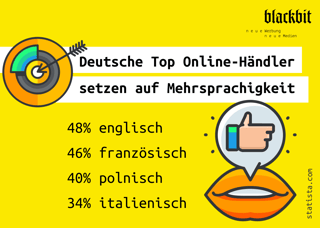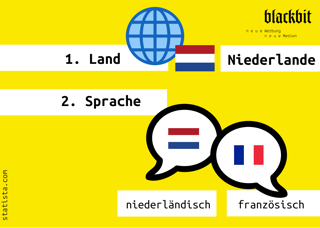Growth with the help of multilingual websites
It is not only country-specific legal and bureaucratic peculiarities that quickly become a challenge when tapping into new European or global markets. For 10% of SMEs, a lack of language and cultural knowledge is an obstacle to the internationalisation of their company. However, expansion is often worthwhile, as there are potential customers for many products, particularly in neighbouring countries and in similar cultural circles. These new customer groups can be tapped into with targeted marketing activities. Of course, this also includes a multilingual website.

The most common language versions in German online shops
At 52.3%, English is the most widely used language on websites (as of January 2017, source: Q-Success via statista.com). 48% of the top 50 online retailers in Germany have a website that is available in English in addition to German - closely followed by language versions in French (46%), Dutch (46%), Polish (40%) and Italian (34%) (source: OC&C; Google via  statista.com). Our customer PEMA - a European leader in the rental of manufacturer-independent commercial vehicles - has its headquarters in Germany, but is at home throughout Europe. This is already clear from the URL pema.eu. The website currently has eight different country versions: Site visitors from Germany, England, Poland, the Czech Republic, Switzerland, Sweden, Denmark and Belgium are addressed in their respective national language. Within the Belgian website version, visitors can switch between French and Dutch using a language switch.
statista.com). Our customer PEMA - a European leader in the rental of manufacturer-independent commercial vehicles - has its headquarters in Germany, but is at home throughout Europe. This is already clear from the URL pema.eu. The website currently has eight different country versions: Site visitors from Germany, England, Poland, the Czech Republic, Switzerland, Sweden, Denmark and Belgium are addressed in their respective national language. Within the Belgian website version, visitors can switch between French and Dutch using a language switch.
The advantages of different language and country versions:
Tapping into new markets: 90% of internet users in the EU prefer websites in their native language. Only 18% of users buy products online on foreign-language  sites.
sites.
Retailers can therefore open up new sales markets and significantly increase their sales opportunities abroad by expanding their external presentation with language differentiation.
Market-specific content: Due to regional differences in mentality, it often makes more sense to provide country-specific content. When formulating the product description, it should be taken into account that different product benefits or application scenarios may be relevant for the individual nationalities. Playful product photos may be very popular in Japan or China, whereas they may appear too cheesy to visitors from other countries.
Relevance for internal communication
A company's website is to a certain extent the digital home of its employees. It should therefore be available in the languages of all countries in which company locations exist. This strengthens the employees' sense of belonging, ensures a more positive external image and facilitates the flow of information between customers and employees in service and support.
Do you have any questions or would you like a personal consultation?
Why Server-Side Tracking Is Becoming Indispensable for Pimcore Projects
When a Delicatessen Refines Its Marketing - And We Supply the Right Ingredients
Blackbit at Web Summit 2025: Experience E-Commerce Trends Live
Webinar: From Google to ChatGPT - How to Stay Visible in AI Search

Leave us feedback